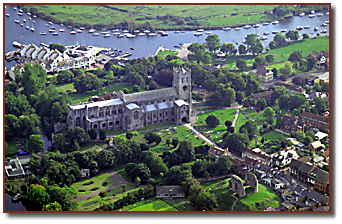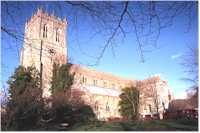![]()

![]()
continuing the series by Father Ron Bowles
I become a Rector

Aerial view of Christchurch Priory
During one of our holidays, we went to worship at Christchurch Priory. Afterwards, we had a conversation with the vicar. This led to our moving to Christchurch a few months later. A vacancy had arisen for a curacy at the Priory, but with the main role as looking after a daughter-church. This turned out to be St George's, Jumpers. Jumpers (thought to be a corruption of Junipers) was a large area on the north side of Christchurch, and a delightful brick church had been built in 1928. A curate's house next door had been built in the fifties. The Parish Communion had been established for some years, and it was a well attended church. In 1956, when we arrived, church going was quite good, and even Sunday Schools were still flourishing. The services were still the old Prayer Book, for liturgical reform hadn't arrived.
Soon after we started, the Suez crisis took place. The country and the church were deeply divided. Colonel Nasser had taken over the Suez Canal, and Britain and France had invaded Egypt. Our local MP (Tory) was against the landing and he lost his job. They were disturbing times.
We had a lively Youth Club, and I have a vivid memory of hearing Rock and Roll for the first time. After that, our traditional youth clubs lost much of their appeal. My other memory of that time was the success of Bournemouth Football Club. They reached the 6th round of the F A Cup, before losing to the famous Busby Babes, the Manchester United side that crashed in Munich. Tickets for that match were sold at the Bournemouth match a week earlier, when alas! I had a wedding. But, praise be, Mary actually got a ticket for me. A real tribulation, for football is not her scene. Our children were at the toddler stage, so we were tied up with all those joys!

Christchurch Priory
After three years, the Bishop of Winchester offered me a living near Southampton. Nursling with Rownhams. Not names we knew, but we found they were on either side of the road from Southampton to Romsey. At that time, there was no M27, but today that road goes through the middle of the parish. St Boniface, Nursling lies just to the north of the M27, and you can see the church quite clearly. St Boniface had lived at the monastery there. The present church is on the site of that monastery. Boniface (born as Winfrith) came from Devon in the 8th century; He is famous for being one of the first missionaries to Germany. He became Archbishop of Mainz. It was due to him, and the dozens of priests, who followed him, that Germany first became a Christian Country.
The 12th century church had some glebe land, which meant that some of the priest's stipend came in part from the glebe rent. This is why he is called a Rector. On the other side of the Romsey road was a newer church (1855) St John's the Evangelist. Friends of Keble, from Hursley began it, so it had a Tractarian tradition - A whole set of Eucharist vestments, which was unusual at that time. Rownhams had become almost a suburb of Southampton, and had developed into a large area. The Ordinance Survey offices were nearby and many worked there. When we arrived the old vicarage (1855) was still standing (it is now demolished). It was an enormous Gothic building - seven bedrooms, huge rooms (ceilings over 12ft high), stable block and cellar. In the grounds (a good acre) were azaleas, rhododendrons and a sunken lawn, over a hundred years old, and in excellent condition. A parishioner offered me a Victorian croquet set, if I learnt the proper rules. Happily I passed her test, and croquet became a favourite game. The school was at the bottom of the garden. It was an ideal setting for a young family. We also had a couple of beagle dogs, which gave us great pleasure.
Near Nursling church was an Elizabethan manor house, which had become a preparatory school for boys. The school provided a choir, and attended the Parish Communion. So, in term time, we had a full church. Rownhams was the larger parish, and we had an earlier Parish communion. When you are young, two full services and an 8 o'clock seem manageable.
It was my first experience of church schools. They were known as controlled schools. That is, though owned by the Church, they were under state control, which limited what you could do over RE teaching. However, it meant, I could go to school twice a week for assembly and lessons. Both churches had good Sunday Schools and Youth Clubs.
This was the 60's. Several national events stand out. The crisis over Cuba, when World War 3 seemed so close. President Kennedy's assassination. Three months when snow lay on the ground. There was a different feeling in the air. David Frost introduced "That was the Week That was". In church circles, the Bishop of Woolwich wrote a book called "Honest to God". It introduced the idea of "situation ethics", i.e. that the old rules of behaviour were not important. It all depended on circumstances. This was the start of the easygoing attitudes, which everyone seems to accept these days.
When it was proposed to put a motorway through the parish, you can imagine the reaction of the villages. However, when you drive through the M27, past Rownhams Service Station, the villages are hardly noticed. Our holidays at that time were "busman's holidays". We used to exchange vicarages in August, and take the services of my locum. It meant we could spend time in Yorkshire, Derbyshire, Norfolk and other counties. Not much of a break, but the best we could manage.
The work of the parish went on. Schools, visiting, services, meetings. Time with a young family. I've always followed the local football team, so I used to watch the Saints. (Tell it not at Fratton Park. After all, I'm now a Blue Army fan).
One day when the Bishop of Winchester came, he asked if I enjoyed suburban life. I said I did, but often thought I'd like an inner city parish. Shortly afterwards, I received a letter from him, but that is another tale which will be continued on another occasion.
Fr Ron Bowles
![]() Return to the March 1999 Features page
Return to the March 1999 Features page
![]() return to Home page and main index
return to Home page and main index
page last updated 1 MARCH 1999